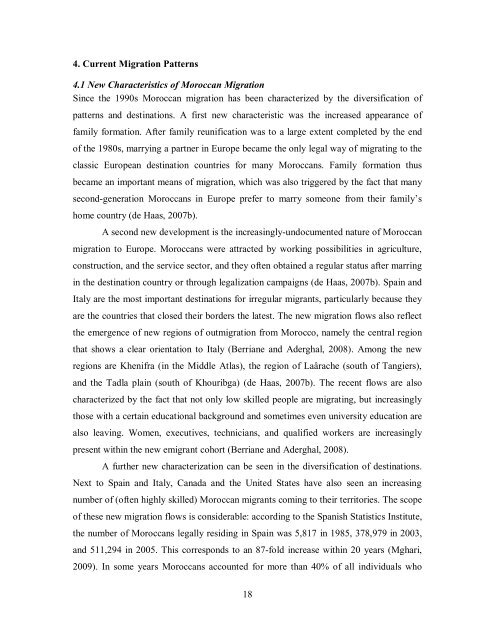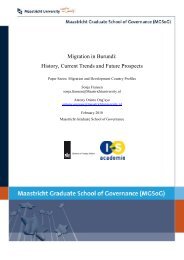Migration in Morocco: History, Current Trends and Future ... - MGSoG
Migration in Morocco: History, Current Trends and Future ... - MGSoG
Migration in Morocco: History, Current Trends and Future ... - MGSoG
You also want an ePaper? Increase the reach of your titles
YUMPU automatically turns print PDFs into web optimized ePapers that Google loves.
4. <strong>Current</strong> <strong>Migration</strong> Patterns<br />
4.1 New Characteristics of Moroccan <strong>Migration</strong><br />
S<strong>in</strong>ce the 1990s Moroccan migration has been characterized by the diversification of<br />
patterns <strong>and</strong> dest<strong>in</strong>ations. A first new characteristic was the <strong>in</strong>creased appearance of<br />
family formation. After family reunification was to a large extent completed by the end<br />
of the 1980s, marry<strong>in</strong>g a partner <strong>in</strong> Europe became the only legal way of migrat<strong>in</strong>g to the<br />
classic European dest<strong>in</strong>ation countries for many Moroccans. Family formation thus<br />
became an important means of migration, which was also triggered by the fact that many<br />
second-generation Moroccans <strong>in</strong> Europe prefer to marry someone from their family’s<br />
home country (de Haas, 2007b).<br />
A second new development is the <strong>in</strong>creas<strong>in</strong>gly-undocumented nature of Moroccan<br />
migration to Europe. Moroccans were attracted by work<strong>in</strong>g possibilities <strong>in</strong> agriculture,<br />
construction, <strong>and</strong> the service sector, <strong>and</strong> they often obta<strong>in</strong>ed a regular status after marr<strong>in</strong>g<br />
<strong>in</strong> the dest<strong>in</strong>ation country or through legalization campaigns (de Haas, 2007b). Spa<strong>in</strong> <strong>and</strong><br />
Italy are the most important dest<strong>in</strong>ations for irregular migrants, particularly because they<br />
are the countries that closed their borders the latest. The new migration flows also reflect<br />
the emergence of new regions of outmigration from <strong>Morocco</strong>, namely the central region<br />
that shows a clear orientation to Italy (Berriane <strong>and</strong> Aderghal, 2008). Among the new<br />
regions are Khenifra (<strong>in</strong> the Middle Atlas), the region of Laârache (south of Tangiers),<br />
<strong>and</strong> the Tadla pla<strong>in</strong> (south of Khouribga) (de Haas, 2007b). The recent flows are also<br />
characterized by the fact that not only low skilled people are migrat<strong>in</strong>g, but <strong>in</strong>creas<strong>in</strong>gly<br />
those with a certa<strong>in</strong> educational background <strong>and</strong> sometimes even university education are<br />
also leav<strong>in</strong>g. Women, executives, technicians, <strong>and</strong> qualified workers are <strong>in</strong>creas<strong>in</strong>gly<br />
present with<strong>in</strong> the new emigrant cohort (Berriane <strong>and</strong> Aderghal, 2008).<br />
A further new characterization can be seen <strong>in</strong> the diversification of dest<strong>in</strong>ations.<br />
Next to Spa<strong>in</strong> <strong>and</strong> Italy, Canada <strong>and</strong> the United States have also seen an <strong>in</strong>creas<strong>in</strong>g<br />
number of (often highly skilled) Moroccan migrants com<strong>in</strong>g to their territories. The scope<br />
of these new migration flows is considerable: accord<strong>in</strong>g to the Spanish Statistics Institute,<br />
the number of Moroccans legally resid<strong>in</strong>g <strong>in</strong> Spa<strong>in</strong> was 5,817 <strong>in</strong> 1985, 378,979 <strong>in</strong> 2003,<br />
<strong>and</strong> 511,294 <strong>in</strong> 2005. This corresponds to an 87-fold <strong>in</strong>crease with<strong>in</strong> 20 years (Mghari,<br />
2009). In some years Moroccans accounted for more than 40% of all <strong>in</strong>dividuals who<br />
18



